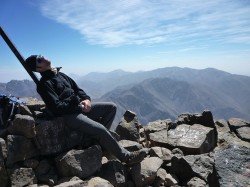
Signaling one or two of the aforementioned complaints (for example, a slight headache and some fluid retention on the face) is not in itself a cause for immediate concern. At altitude sickness it must always concern several complaints at the same time. However, most people who suffer from altitude sickness do not have all the symptoms at the same time. When do you have to start worrying?
Because altitude sickness can be a serious illness, it is internationally agreed what a good definition is. It is then clear to everyone at what time the treatment should be started. The overview below shows what has been agreed by experts in the field of altitude sickness as a definition of altitude sickness (the Lake Louise Consensus of 1991). If you meet the following conditions, you have acute altitude sickness unless otherwise proven. You must therefore act as if you have altitude sickness. There is no room for stubborn people who think they know better, given the dangers that now threaten to climb further!
Do I have acute altitude sickness?
I have acute altitude sickness if all points 1 to 3 are correct.
1. I recently climbed (the last 1 to 2 days) (usually sleeping more than 300 meters higher per day).
2. I have been at the new height for at least a few hours.
3. I have a headache that I didn't have before climbing.
And if I also have at least one of the complaints A to D.
A) I am nauseous, lack appetite, or have to vomit.
B) I am very tired or feel abnormally weak.
C) I feel lightheaded or dizzy.
D) I have trouble sleeping, while I normally sleep well.
The severity of the altitude sickness can, according to a system established at the same Lake Louise conference, be expressed in points, the AMS score. By determining your point score a day to day, you can follow how you are doing. Under normal circumstances this makes no sense, it spoils your holiday pleasure of constantly being concerned with your health. Only for people who are very scared of altitude sickness or who know they are sensitive to it, tracking your score over time can be a useful tool.
Incidentally, acute altitude sickness is almost never a serious threat to your health, as long as you do what is recommended. Some experts call this acute form of altitude sickness, which is therefore not associated with problems of the brain and lungs, 'benign' altitude sickness. This is in contrast to the forms that are potentially life-threatening and that are called 'malignant' altitude sickness. With the good-natured form you usually do not have to interrupt your holiday or expedition definitively; with the evil forms that is usually the case and you always have to descend. Only a small percentage, estimated at around 5%, of people with benign acute altitude sickness subsequently develop the malignant form. However, people with acute altitude sickness should be closely monitored despite this small chance, as the consequences can be very serious.
Author: Han Willems - More info about altitude sickness
